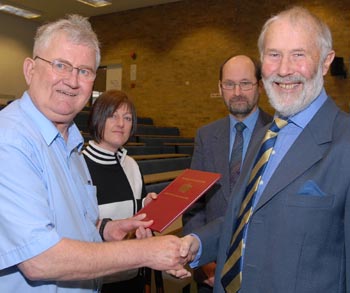Weather station marks 30th anniversary

An official Met Office weather station owned by Lancaster University has celebrated its 30th birthday with an award from the Chancellor Sir Christian Bonington.
The station at Hazelrigg north of campus has been taking measurements every day since 1976.
The 30th anniversary means that now weather records from Hazelrigg qualify for inclusion in world climate reports and an analysis of long term trends by the World Meteorological Organisation.
Sir Christian presented an award to Martin Beadle who recorded the data at 0900GMT every day until his retirement in 2001.
He said: “I remember the times when the wind was blowing so hard I had to hold my spectacles on and times when the snow would build up on them so I could hardly see. You have to be reliable, accurate and not too shy of bad weather to do the job well.”
He said he was always fascinated by the weather.
“I read every book in the school library on weather from cover to cover. What I read in the book made sense when I looked at the sky, though I observe the weather – I can’t predict it!”
Also receiving awards were the current weather observer at Hazelrigg Debbie Hurst and John Adamson, who runs the 75 year old Moor House weather station in the North Pennines. Both weather stations were established by Gordon Manley, Lancaster’s first Professor of Environmental Studies.
Jim McGhee of the Met Office said Hazelrigg is highly valued.
“There aren’t many stations like this which have been recording data for 30 years and it’s very important.”
Sir Christian said Hazelrigg has a role to play in tracking climate change.
“Global warming is going to affect our entire society and therefore these observations are of the utmost importance.”
He said he had noticed how snow has disappeared from his home in the Lake District over the past 30 years and even from the top of Everest, which had a ridge of snow when he first ascended the summit in 1985.
Dr Rob MacKenzie of the Environmental Science Department is in charge of the weather station.
“The measurements suggest it’s been getting warmer, and we’re finding that the warmest and wettest months are in more recent years. This leads us to suppose that the climate is changing.”
Hazelrigg is also used for other scientific projects, including an investigation of how condensation trails from aeroplanes are affecting the atmosphere and how sunshine levels in the past have been affected by pollution from coal fires and heavy industry.
Dr MacKenzie said: “It feels like all the effort is worth it when you see the data being used to produce good science.”
Hazelrigg weather station is supplied with automatic data logging by Campbell Scientific, who sponsored the meeting.
http://www.campbellsci.co.uk/